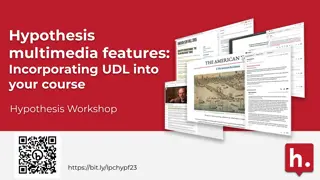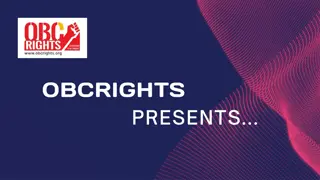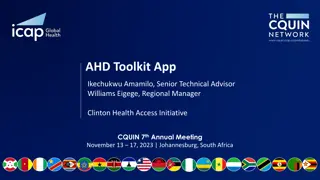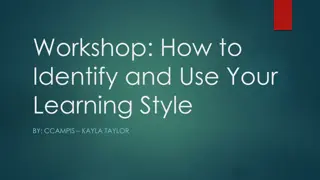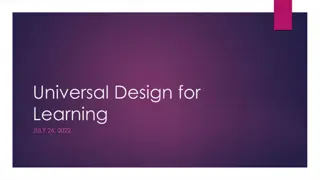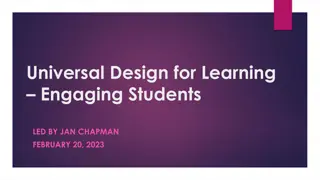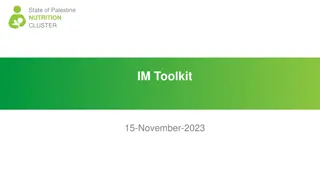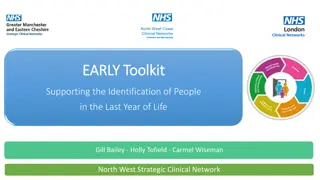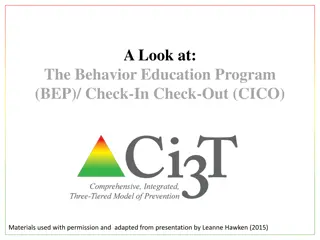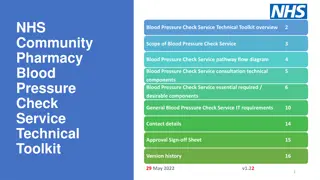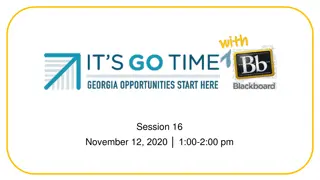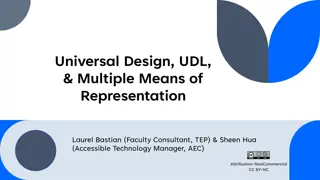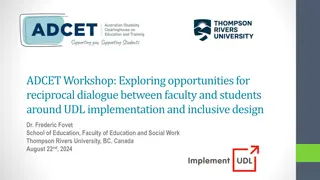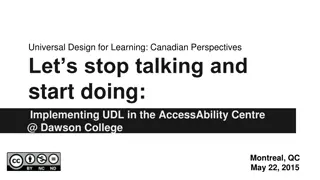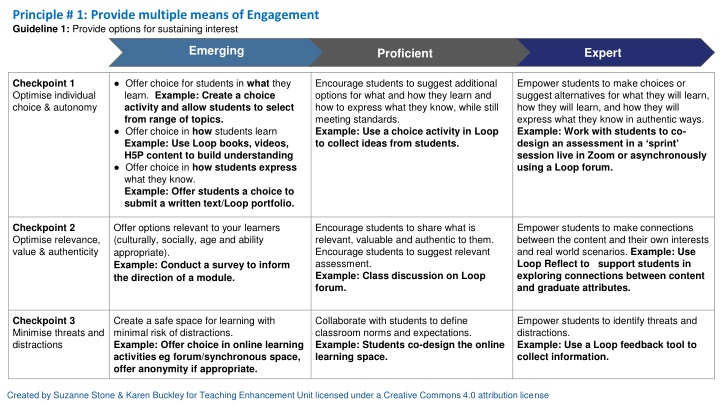
Fostering Engagement and Persistence in Diverse Learning Environments
This comprehensive guide explores ways to provide multiple means of engagement and sustain effort in education. It emphasizes offering choices to students in what they learn, how they learn, and how they express their knowledge. The principles outlined help educators optimize individual choice and autonomy, relevance, value, and authenticity, while minimizing threats and distractions. Strategies for setting clear goals, varying difficulty levels, promoting collaboration, and providing constructive feedback are highlighted to enhance student learning experiences.
Download Presentation

Please find below an Image/Link to download the presentation.
The content on the website is provided AS IS for your information and personal use only. It may not be sold, licensed, or shared on other websites without obtaining consent from the author. If you encounter any issues during the download, it is possible that the publisher has removed the file from their server.
You are allowed to download the files provided on this website for personal or commercial use, subject to the condition that they are used lawfully. All files are the property of their respective owners.
The content on the website is provided AS IS for your information and personal use only. It may not be sold, licensed, or shared on other websites without obtaining consent from the author.
E N D
Presentation Transcript
Principle # 1: Provide multiple means of Engagement Guideline 1: Provide options for sustaining interest Emerging Expert Proficient Offer choice for students in what they learn. Example: Create a choice activity and allow students to select from range of topics. Offer choice in how students learn Example: Use Loop books, videos, H5P content to build understanding Offer choice in how students express what they know. Example: Offer students a choice to submit a written text/Loop portfolio. Encourage students to suggest additional options for what and how they learn and how to express what they know, while still meeting standards. Example: Use a choice activity in Loop to collect ideas from students. Empower students to make choices or suggest alternatives for what they will learn, how they will learn, and how they will express what they know in authentic ways. Example: Work with students to co- design an assessment in a sprint session live in Zoom or asynchronously using a Loop forum. Checkpoint 1 Optimise individual choice & autonomy Offer options relevant to your learners (culturally, socially, age and ability appropriate). Example: Conduct a survey to inform the direction of a module. Encourage students to share what is relevant, valuable and authentic to them. Encourage students to suggest relevant assessment. Example: Class discussion on Loop forum. Empower students to make connections between the content and their own interests and real world scenarios. Example: Use Loop Reflect to support students in exploring connections between content and graduate attributes. Checkpoint 2 Optimise relevance, value & authenticity Create a safe space for learning with minimal risk of distractions. Example: Offer choice in online learning activities eg forum/synchronous space, offer anonymity if appropriate. Collaborate with students to define classroom norms and expectations. Example: Students co-design the online learning space. Empower students to identify threats and distractions. Example: Use a Loop feedback tool to collect information. Checkpoint 3 Minimise threats and distractions Created by Suzanne Stone & Karen Buckley for Teaching Enhancement Unit licensed under a Creative Commons 4.0 attribution license
Principle # 1: Provide multiple means of Engagement Guideline 2: Provide options for sustaining effort and persistence Emerging Expert Proficient Build in reminders of both goals and the value of those goals. Example: Add Learning Outcomes to the Loop page. Encourage students to collaboratively discuss goals in light of students' own passions and interests and to choose from various options to reach the goals. Example: Use a Loop forum. Students create personal goals for how they will learn, express the content, and challenge themselves while learning. Example: Ask students to use Loop Reflect to create personal goals. Checkpoint 4 Heighten relevance of goals and objectives Provide options for students to learn content with clear degrees of difficulty Example: Provide text and video resources. Provide choices for students to learn content with clear degrees of difficulty and reflect on these degrees of difficulty in relation to their own strategy for learning. Example: Offer a range of resources on Loop: primary source documents, summary documents, videos, podcasts. Empower students to select their own content and/or own assessments, based on standards Example: Use a Loop choice to offer a variety of content options/assessments. Checkpoint 5 Vary demands and resources to optimise challenge Provide opportunities for students to learn how to work effectively with others. Example: Create group assessments on Loop. Develop a classroom that values collaborative group work. Students construct their own groups and create their own group norms, responsibilities, etc. and students often seek out and work with diverse partners. Create a classroom culture where students work together to define goals, create strategies, provide feedback to each other and push each other with mastery-oriented feedback while building integrative thinking. Checkpoint 6 Foster collaboration & community Provide feedback that guides learners toward mastery rather than a fixed notion of performance or compliance. Example: Provide online feedback that includes links to supporting resources. Empower students to provide mastery oriented feedback to each other to support specific improvement and increased effort and persistence. Example: Use the Workshop activity. Empower students to use mastery oriented feedback independently to self-reflect, self- direct, and pursue personal growth in areas of challenge. Example: Use Loop Reflect. Checkpoint 7 Increase mastery- oriented feedback Created by Suzanne Stone & Karen Buckley for Teaching Enhancement Unit licensed under a Creative Commons 4.0 attribution license
Principle # 1: Provide multiple means of Engagement Guideline 3: Provide options for self regulation Emerging Expert Proficient Use language and feedback that will allow all students to see themselves as capable learners. Example: Use the progress bar on Loop. Foster conversations with students to develop relationships and make authentic connections and use their personal passions and interests to help inspire them and push them toward success. Example: Use Discussion forum. Create a classroom culture where students are empowered and able to support their own self-talk and support one another's positive attitudes toward learning. Example: Use Discussion forum/Zoom breakout room discussions. Checkpoint 8 Promote expectations and beliefs that optimize motivation Offer reminders, models, and tools, to assist learners in managing and directing their emotional responses. Offer options for stress release such as alternate seating, fidget tools, mindfulness breaks, etc. Examples: Include links to well being resources and student support services. Provide space in live Zoom lectures for social chat. Empower students to deal with difficult challenges by allowing them to choose from multiple strategies to regulate their learning. Example: Encourage students to set up their own independent Zoom sessions for social learning. Encourage students to self-reflect, accurately interpret their feelings, and use appropriate coping strategies and skills to foster learning for themselves and their classmates. Example: Encourage students to use Loop Reflect to self reflect in a safe space. Direct to well-being resources and student support services to support this process. Checkpoint 9 Facilitate personal coping skills and strategies Provide students with tools to reflect on their learning through rubrics, marking guides, self-assessment, etc. Example: Use Loop Rubrics/Marking Guides to offer students transparency and consistency in assessment. Offer multiple models and scaffolds for self assessment so that students can choose ones that suit their individual needs. Example: Offer students choice in the means of collecting/displaying data from their own behaviour/academic performance to monitor growth, eg Progress Bar/Quiz/Loop Reflect. Create a culture where students consistently reflect on the learning process and assessments so they become self- directed learners who grow over time. Example: Include Loop Reflect as a tool for assessment formative/summative. Checkpoint 10 Minimise threats and distractions Created by Suzanne Stone & Karen Buckley for Teaching Enhancement Unit licensed under a Creative Commons 4.0 attribution license
Principle # 2: Provide multiple means of Representation Guideline 1: Provide options for perception Emerging Expert Proficient Create resources and materials that address variability and meet the needs of more students. Example: Include the accessibility block on your Loop page. Create resources and materials that students can access electronically. Allow students to use their devices to interact with textual, visual and audio information so they can personalize, take notes, increase/decrease size/ volume, etc. Example: Use H5P to create interactive content and include options for students to download their interactions with the material. Empower students to choose resources and materials that best meet their needs. Example: Provide a video and text version of content. Checkpoint 11 Offer ways of customizing the display of information Provide an embedded option for any information presented aurally. Example: Provide closed-captions for video (automatic in YouTube) Provide multiple options for students to choose alternatives to learn content so they don't have to rely on auditory information. Example: Closed captions for video or the choice of reading a text. Empower students to select auditory alternatives as well as provide them with a framework to locate additional, reputable resources to build their understanding. Example: Provide resources on Loop to auditory alternatives and links to Library resources around Information Literacy. Checkpoint 12 Offer alternatives for auditory information Provide an embedded option for students so they don't have to rely on visual information. Example: Provide audio/video alternatives to visual information. Provide multiple options for students to choose alternatives to learn content so they don't have to rely on visual information. Example: Provide a link to an audiobook as an alternative to text based resources. Empower students to select alternatives to visual information and provide them with a framework to locate additional, reputable resources to build their understanding. Example: Provide resources on how to determine if a website/author is credible. Checkpoint 13 Offer alternatives for visual information Created by Suzanne Stone & Karen Buckley for Teaching Enhancement Unit licensed under a Creative Commons 4.0 attribution license
Principle # 2: Provide multiple means of Representation Guideline 2: Provide options for language, mathematical expressions, and symbols Emerging Expert Proficient Translate idioms, archaic expressions, culturally exclusive phrases, and slang. Example: Provide a Glossary of relevant terms on Loop. Provide students with in context clues to support independent learning. Example: Use auto-links from the glossary tool for text based resources. Empower students to work collaboratively to use relevant vocabulary. Example: A collaborative glossary assignment. Checkpoint 14 Clarify vocabulary and symbols Clarify unfamiliar syntax. Example: Use auto linking in the glossary tool. Provide students with resources that will allow they themselves to clarify syntax and structure. Example: Provide a glossary on Loop. Empower students to preview material and highlight areas in need of clarification. Example: Provide content on Loop & use the choice tool to gather feedback. Checkpoint 15 Clarify syntax and structure Provide direct instruction, prompts, and scaffolded materials for students who struggle to comprehend information. Example: Provide alternatives, such as visuals, to support this understanding. Provide strategies and materials that lower barriers to understand and help students figure out notations, symbols, or problems. Example: Provide math reference sheets, context clue strategies on Loop. Empower students to independently utilize learned strategies to decode text, mathematical notation, and symbols. Example: Provide guidance on using resources. Checkpoint 16 Support decoding of text, mathematical notation, and symbols Make key information in the dominant language available in the first languages of learners with limited-English proficiency. Example: Provide alternative presentations of material. Provide students with access to tools such as apps, websites, and dictionaries to translate material under study and to collaboratively build understanding. Example: Provide online resources. Empower students to independently utilize options to translate material under study, and collaborate to build understanding. Example: Create a collaborative glossary activity. Checkpoint 17 Promote understanding across languages Present key concepts in one form of symbolic representation. Example: Provide an alternative to text eg video/audio/diagram. Provide multiple options and symbolic representations to build comprehension. Example: Use H5P dialogue cards to add audio and image alternatives to key concepts. Empower students to choose effective resources from multiple options with multiple representations . Example: Provide guidance around choosing resources. Checkpoint 18 Illustrate through multiple media Created by Suzanne Stone & Karen Buckley for Teaching Enhancement Unit licensed under a Creative Commons 4.0 attribution license
Principle # 2: Provide multiple means of Representation Guideline 3: Provide options for comprehension Emerging Expert Proficient Provide all students with background information on content using direct instruction with options for visuals, audio etc. Example: Provide online resources as above. Provide students with options that supply or activate relevant prior knowledge. Example: Create a collaborative Wiki/Glossary/Database activity and encourage students to source resources that will allow them to build appropriate background knowledge. Empower students to determine gaps in their own background knowledge and then select appropriate resources to build that knowledge in line with learning outcomes. Example: Use a questionnaire as a diagnostic assessment. Ask students to use this questionnaire data to create a strategy for filling in gaps in learning. Checkpoint 19 Activate or supply background knowledge Provide explicit cues or prompts to help students recognise the most important features in information. Example: Use the glossary autolink function to reference key concepts. Provide students with options and multiple strategies to support recognition of the most important features in information. Example: Encourage students to use the glossary auto-linking feature. Empower students to self-reflect on effective strategies for highlighting critical information. Example: Create a collaborative/individual glossary activity. Checkpoint 20 Highlight patterns, critical features, big ideas, and relationships Provide all students with materials, strategies, and tools to support processing and visualization. Example: Loop Glossary. Provide students with options of multiple materials, strategies, and tools to use to support processing and visualization. Example: Provide links to resources such as visual notes tools. Empower students to self-reflect and independently choose the most appropriate materials, strategies, and tools to guide information processing, visualization. Example: Provide guidance around tools provided. Checkpoint 21 Guide information processing, visualization, and manipulation Model explicit strategies students can use to transfer the information they have to other content areas and situations. Example: Provide resources that demonstrate show how the knowledge could be used in another class. Provide options for meaningful transfer, such as interdisciplinary projects, where students can make authentic connections and apply knowledge in meaningful ways in other content areas and in authentic situations. Example: Loop Reflect assignment/activity. Encourage students to apply knowledge/skills learned in class to enhance their understanding of content and express their knowledge and understanding in authentic, real-world scenarios. Example: Loop Reflect assignment/activity. Checkpoint 22 Maximize transfer and generalization Created by Suzanne Stone & Karen Buckley for Teaching Enhancement Unit licensed under a Creative Commons 4.0 attribution license
Principle # 3: Provide multiple means of Action & Expression Guideline 1:Provide options for physical action Emerging Expert Proficient Provide more than one option for the methods used for response and navigation within the same assignment. Example: Provide options on Loop for students to collate ideas eg discussion forum/online journal. Provide multiple options for the methods used for response and navigation within the same assignment. Example: some students may use IPads, different writing utensils, keyboards, voice recognition software, etc. Empower students to use their own devices to respond to and interact with materials for all assignments. Example: options to use headphones, keyboards. Checkpoint 23 Vary the methods for response and navigation Allow some students to use assistive technologies for navigation, interaction, and composition. Example: Encourage students to use the Accessibility block. Provide multiple options for all students to use assistive technology. Example: Encourage students to use the Accessibility block. Empower students to assess the need for and choose technologies that work for them to provide additional, personalized options to express their knowledge and skills. Example: Provide information on Loop around assistive technologies and link to resources provided by Student Support services. Checkpoint 24 Optimize access to tools and assistive technologies Created by Suzanne Stone & Karen Buckley for Teaching Enhancement Unit licensed under a Creative Commons 4.0 attribution license
Principle # 3: Provide multiple means of Action & Expression Guideline 2: Provide options for expression and communication Emerging Expert Proficient Provide more than one way to answer on assessments so students can express their understanding without barriers. Example: Create an assignment where students have options to create a text assignment or a video submission. Provide students with multiple options to express their understanding, allow then suggest some ways of being assessed. This will encourage understanding of the assessment process. Example: Provide examples of assignments to stimulate discussion. Allow students reflect on a set of competency/proficiency based rubrics, and then independently create authentic and innovative products that allow them to demonstrate their mastery of the standard. Example: Allow students to develop a rubric on Loop from a template. Checkpoint 25 Use multiple media for communication Provide the choice of more than one tool or strategy to help students express their knowledge. Example: Allow students options around assessment eg use Unicam to create a video assignment. Provide multiple tools and strategies to help students express their knowledge. Example: Provide options for students regarding assignment submission eg create a glossary, create a video, create an animation. Students are empowered to self-reflect and select tools and materials that will support their learning when submitting assignments. Example: Encourage students to use Loop Reflect to record their thoughts on assignment options. Checkpoint 26 Use multiple tools for construction and composition Implement a scaffolding model from teacher-directed to collaborative groups to independent work, slowly releasing responsibility to students. Example: Use the group functionality in Loop to create a collaborative assessments. Assign team members specific tasks and monitor their progress before releasing a second assignment for independent work using restrict access functionality. Provide options for support and scaffolding throughout the learning process and encourage students to choose resources that allow them to build their own knowledge while working in collaborative groups and working independently. Example: In a discussion forum, encourage students to collaborate to design the rules of engagement for the discussion. Encourage students to provide feedback and drive teacher instruction; encourage them to define roles and expectations for group work that include routine monitoring and reflection. Example: Use the feedback tool to allow students to offer feedback on their learning. Checkpoint 27 Build fluencies with graduated levels of support for practice and performance Created by Suzanne Stone & Karen Buckley for Teaching Enhancement Unit licensed under a Creative Commons 4.0 attribution license
Principle # 3: Provide multiple means of Action & Expression Guideline 3: Provide options for executive functions Emerging Expert Proficient Provide clear goals to students on what they must do to meet or exceed expectations. Example: Provide learning outcomes on Loop. Create conditions for learners to develop goal setting skills. Example: Provide examples of the process and product of goal setting to deepen understanding. Encourage students to create personalized learning plans and strategies that optimize personal strengths while addressing individualized areas of challenge. Example: Encourage students to use Loop Reflect to create learning plans. Checkpoint 28 Guide appropriate goal-setting Facilitate the process of strategic planning. Example: Provide all students with checklists for tasks, due dates, and planning templates to keep students organized. Facilitate the process of strategic planning. Example: Provide students with organizational tools and relevant scaffolds they need to create personalised strategies to meet their goals. Empower students to self-reflect, self assess, and create personalized action plans to achieve their identified goals. Example: Encourage students to use Loop reflect to record the time and resources needed to perform selected tasks. Checkpoint 29 Support planning and strategy development Provide scaffolds and supports to act as organizational aids for students. Example: Provide all students with templates for note-taking. Provide exposure to multiple scaffolds, supports, and resources that act as organization aids. Example: Provide such resources on Loop Empower students to independently choose the most appropriate supports and resources that will allow them to organize information and resources so they can achieve their identified goal(s). Example: Provide guidance around resources on Loop Checkpoint 30 Facilitate managing information and resources Provide formative feedback tools to students so they can monitor their own progress. Example: Allow students to view Urkund text matching reports in advance of final assignment submission. Provide multiple opportunities for students to receive feedback from the teacher, peers, and themselves using a variety of tools. Example: Use the various feedback options available in Loop eg. rubrics, marking guides, annotated PDFs, audio and video feedback. Empower students to use multiple resources, including teachers and peers, to consistently reflect on their performance, collect feedback, and revise their work to promote and highlight growth. Example: Use the My Feedback report** Checkpoint 31 Enhance capacity for monitoring progress Created by Suzanne Stone & Karen Buckley for Teaching Enhancement Unit licensed under a Creative Commons 4.0 attribution license

